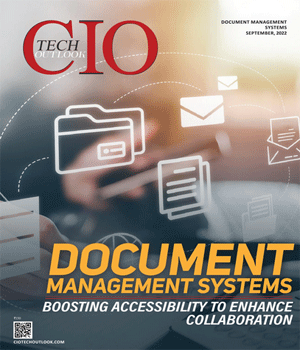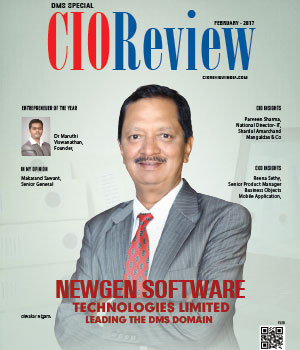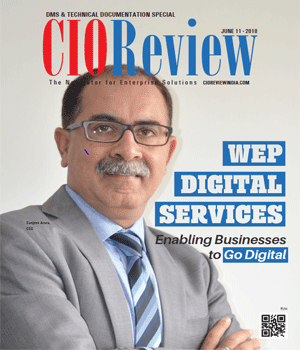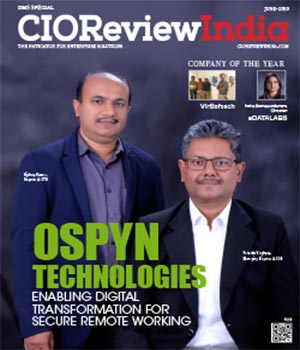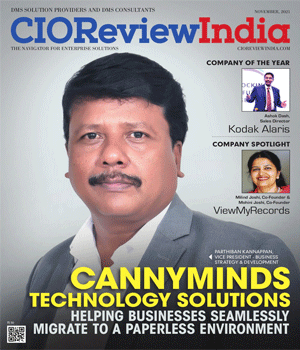
The Art of Document Imaging and Streamlining Document Workflow
CIOReviewIndia Team | Friday, 16 July 2021, 11:59 IST

K Bhaskhar, Senior Vice President - Canon India, in an interaction with Sudhakar Singh, Editor, CIOReview India, shares his views on the current evolution of imaging industry and how document workflow can be streamlined.
How do you see the current document imaging industry in India? What are the major factors driving its growth?
In the first quarter, we saw a good traction and the industry bounced back from the repercussions of the pandemic induced lockdown. The moment offices started opening, the demand rose further for document imaging solution. There is an evident move from standalone devices towards multifunctional devices. Through multifunctional device, users are scanning documents and saving them to the particular folder and keeping one copy for themselves. With automation increasingly becoming imperative, organizations need to maintain documents not only in the physical form but digital form as well to be able to extract information from it when needed.
Today, you can't deploy any application if the documents are not properly digitized. So, the first phase of digitization becomes paramount. Be it in government organizations, large corporates or even SME segment, they are finding a lot of usage of document management solutions. In fact, a lot of people have now started asking that what kind of document management solution you can offer to my organization so that we can become more productive. So, we see a good traction happen in 2021 and the same sentiments are shared by our partners and our sales team.
Once the documents are digitized, what's the next step? How do the new technologies help in integrating the documents or streamlining the whole process of document management?
This is a very important question. Once a document has been digitized, what would you like to do with it? For example, if it's a finance department, they would archive it and store it, with indexing so that at any point of time when auditors come to review some documents, they can see it with a touch of the button. And if needed, those particular documents can be printed and shown to them. On the other hand, some people want a scanned document to be vetted. For example, if there is a tender document, it goes to the finance department and to the superiors for price approval.
The person vetting it doesn't have to search all the pages and find out the terms and conditions. He immediately goes directly to that particular tender sheet, which are pertaining to the terms and conditions. He looks at the terms and conditions and then he puts his remark. Then similarly, the IT department looks at what are the SLAs, what kind of the contract they have, is there any indemnity clause? So, you can just type the keywords and automatically, it will go to that particular page for him to review. So, you just scan the document, and after scanning the document, you can create a searchable PDF form.
Everything gets documented - who has seen the document when and what is the remark that has been made. And every time he's changing the remarks, multiple versions get created automatically. So, every activity gets saved. It is not only in a simple office, it is also applicable in the large government offices. Moreover, there is option to give limited rights about who can see and edit it. That is the power you can get with the DMS solution after the document gets scanned. So, what you're going to get is good convenience and complete security of the document. And whenever you want to retrieve it, you can retrieve it within a fraction of seconds because the path is clear.
Another significant part is getting insights from the document and big data analytics has emerged as one of the tools for the same. How can businesses leverage it to unravel insights that can be used for better decision making?
Organizations are increasingly coming up with new solutions to leverage big data. However, for it to be utilized effectively, CIOs have to deal with the challenge of synchronizing multiple data sets which are there in multiple systems. So, the first and foremost thing to do is to scan the document and index it properly. Then it goes to the main repository so that the big data analytics can be done.
We have a solution called Iris which collects all the information and then the organization takes it in terms of whether they want to do analytics or want to conduct a trend analysis. All this is easier for them to do it once they have a product which can easily synchronize with the existing document management solution.
Could you please elaborate on how the multifunctional devices work and how are they unique?
Multifunctional devices come with a bouquet of functions apart from scanning. For example, you can allow and disallow people for color printing. We see a big traction happening in the multifunctional printers with the color enablement. You don't have to buy a separate color printer and a black and white printer and the machine comes with enabled software to decide who can print color and who cannot. Secondly, it also keeps track of who has printed how many documents. So, that data can be given to the management and the management gets a built-in statistics.
Moreover, after scanning you can push it into your DMS solution with a touch of the button from the multifunctional device. So, all the documents that you scan go to central repository automatically. The machine does a lot of things in terms of the style of printing. It can do print in the form of a booklet. You just give the command after selecting from different forms available in the multifunctional devices. Thus, we give more of a foolproof system and better convenience while enhancing the efficiency.
CIO Viewpoint
Mega Trends In AI & Machine Learning
By Piyush Chowhan, CIO, LuLu Group International
New Phase in Engineering and Designing
By Vilas Pujari, Vice President - Corporate IT, ACG Worldwide
Reaching Out to Targeted Audience with Unique...
By Raghubir Singh, Head-IT, Relaxo Footwears
CXO Insights
Digitally Determined And Digitally Distraught
By Kaushik Mitra, Senior Director, Cloud ERP, Oracle
Data Science & Machine Learning In Fintech
By Jainendra Kumar, Head - Global Delivery Center-India & Senior Director Product Development Software, Diebold NixDorf
5G Will Bring A Data Tsunami: Can Your Data...


